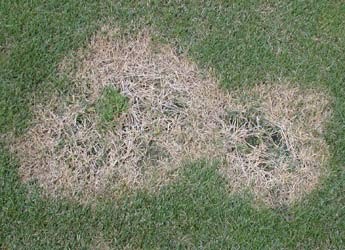Turf & Lawn Blog
Lawn Problems | Part 2 - Dead Patches
Brown, dead patches can appear in any lawn, and are a very common problem. Fortunately, it’s usually possible to identify and treat the cause, and therefore cure it. There are a number of causes of dead patches.
First, when did your patches appear? If after mowing, they may be due to spilt oil or petrol, which can kill lawns. Avoid topping up your petrol or oil on the lawn, and do not overfill tanks. Alternatively, if you have a few high spots, they may be getting ‘scalped’ by the lawnmower, and you may need to raise the height of the blades a little.
If they appeared during dry weather, and are generally near trees, or in sandy areas, then the patch is probably due to lack of soil moisture. Water the area thoroughly every week to ten days during dry periods, and it should recover.

If they appeared after feeding or applying mosskiller to the lawn, the fertiliser or weedkiller may have been too concentrated. Ideally, you should feed just before rain, or water the fertiliser in to prevent any problems. You may also have problems if you have used weedkiller on paths, and it has been walked onto the lawn. Try to avoid walking on the lawn just after spraying, or cover your shoes with plastic bags if you have to do so.
If you have got a dog, and the patches have bright green margins, they may well be due to the dog weeing on the grass. Female dogs’ urine in particular can damage lawn turf. Try to prevent your dog from weeing on the grass, but if you see it happening, water the area thoroughly as soon as possible.
If your house is a new-build, the dead patches may be due to buried builders’ waste, or soil compaction caused by machinery. The bad news is that you will need to dig out the waste or rubble, and dig over the compacted soil before you relay or reseed the lawn or patch.
If your dead patches are spreading rapidly, and you have noticed birds pecking at the lawn, you may have insect grubs feeding on the roots, probably leatherjackets or chafer grubs. You can buy nematodes for chafer grubs, or just wait until they have turned into adults and patch up the damage. Finally, if you have ruled out any other cause, rapidly-spreading dead patches may also be caused by lawn diseases, which generally occur in wet or damp weather. The precise treatment will depend on the disease and is out of scope of this article.
What can you do to treat dead patches? Well, you can reseed or buy turf to fill patches, and we have an article on patching lawns to help you.
When you subscribe to the blog, we will send you an e-mail when there are new updates on the site so you wouldn't miss them.
